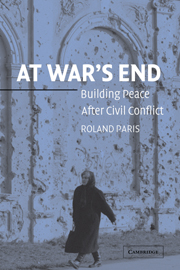28 results
The Right to Dominate: How Old Ideas About Sovereignty Pose New Challenges for World Order
-
- Journal:
- International Organization / Volume 74 / Issue 3 / Summer 2020
- Published online by Cambridge University Press:
- 23 March 2020, pp. 453-489
- Print publication:
- Summer 2020
-
- Article
- Export citation
Global Governance and Power Politics: Back to Basics
-
- Journal:
- Ethics & International Affairs / Volume 29 / Issue 4 / Winter 2015
- Published online by Cambridge University Press:
- 11 December 2015, pp. 407-418
-
- Article
- Export citation
Afghanistan: What Went Wrong?
-
- Journal:
- Perspectives on Politics / Volume 11 / Issue 2 / June 2013
- Published online by Cambridge University Press:
- 21 May 2013, pp. 538-548
- Print publication:
- June 2013
-
- Article
- Export citation
Saving liberal peacebuilding
-
- Journal:
- Review of International Studies / Volume 36 / Issue 2 / April 2010
- Published online by Cambridge University Press:
- 23 April 2010, pp. 337-365
- Print publication:
- April 2010
-
- Article
- Export citation
9 - The Limits of Wilsonianism: Understanding the Dangers
-
- Book:
- At War's End
- Published online:
- 05 September 2012
- Print publication:
- 24 May 2004, pp 151-178
-
- Chapter
- Export citation
5 - Cambodia and Liberia: Democracy Diverted
-
- Book:
- At War's End
- Published online:
- 05 September 2012
- Print publication:
- 24 May 2004, pp 79-96
-
- Chapter
- Export citation
7 - Nicaragua, El Salvador, and Guatemala: Reproducing the Sources of Conflict
-
- Book:
- At War's End
- Published online:
- 05 September 2012
- Print publication:
- 24 May 2004, pp 112-134
-
- Chapter
- Export citation
6 - Bosnia and Croatia: Reinforcing Ethnic Divisions
-
- Book:
- At War's End
- Published online:
- 05 September 2012
- Print publication:
- 24 May 2004, pp 97-111
-
- Chapter
- Export citation
List of Figures
-
- Book:
- At War's End
- Published online:
- 05 September 2012
- Print publication:
- 24 May 2004, pp viii-viii
-
- Chapter
- Export citation
Contents
-
- Book:
- At War's End
- Published online:
- 05 September 2012
- Print publication:
- 24 May 2004, pp vii-vii
-
- Chapter
- Export citation
PART II - THE PEACEBUILDING RECORD
-
- Book:
- At War's End
- Published online:
- 05 September 2012
- Print publication:
- 24 May 2004, pp 53-54
-
- Chapter
- Export citation
10 - Toward More Effective Peacebuilding: Institutionalization Before Liberalization
-
- Book:
- At War's End
- Published online:
- 05 September 2012
- Print publication:
- 24 May 2004, pp 179-211
-
- Chapter
- Export citation

At War's End
- Building Peace after Civil Conflict
-
- Published online:
- 05 September 2012
- Print publication:
- 24 May 2004
PART III - PROBLEMS AND SOLUTIONS
-
- Book:
- At War's End
- Published online:
- 05 September 2012
- Print publication:
- 24 May 2004, pp 149-150
-
- Chapter
- Export citation
3 - Introduction to the Case Studies
-
- Book:
- At War's End
- Published online:
- 05 September 2012
- Print publication:
- 24 May 2004, pp 55-62
-
- Chapter
- Export citation
Introduction
-
- Book:
- At War's End
- Published online:
- 05 September 2012
- Print publication:
- 24 May 2004, pp 1-10
-
- Chapter
- Export citation
8 - Namibia and Mozambique: Success Stories in Southern Africa?
-
- Book:
- At War's End
- Published online:
- 05 September 2012
- Print publication:
- 24 May 2004, pp 135-148
-
- Chapter
- Export citation
PART I - FOUNDATIONS
-
- Book:
- At War's End
- Published online:
- 05 September 2012
- Print publication:
- 24 May 2004, pp 11-12
-
- Chapter
- Export citation
Preface
-
- Book:
- At War's End
- Published online:
- 05 September 2012
- Print publication:
- 24 May 2004, pp ix-xii
-
- Chapter
- Export citation
1 - The Origins of Peacebuilding
-
- Book:
- At War's End
- Published online:
- 05 September 2012
- Print publication:
- 24 May 2004, pp 13-39
-
- Chapter
- Export citation



